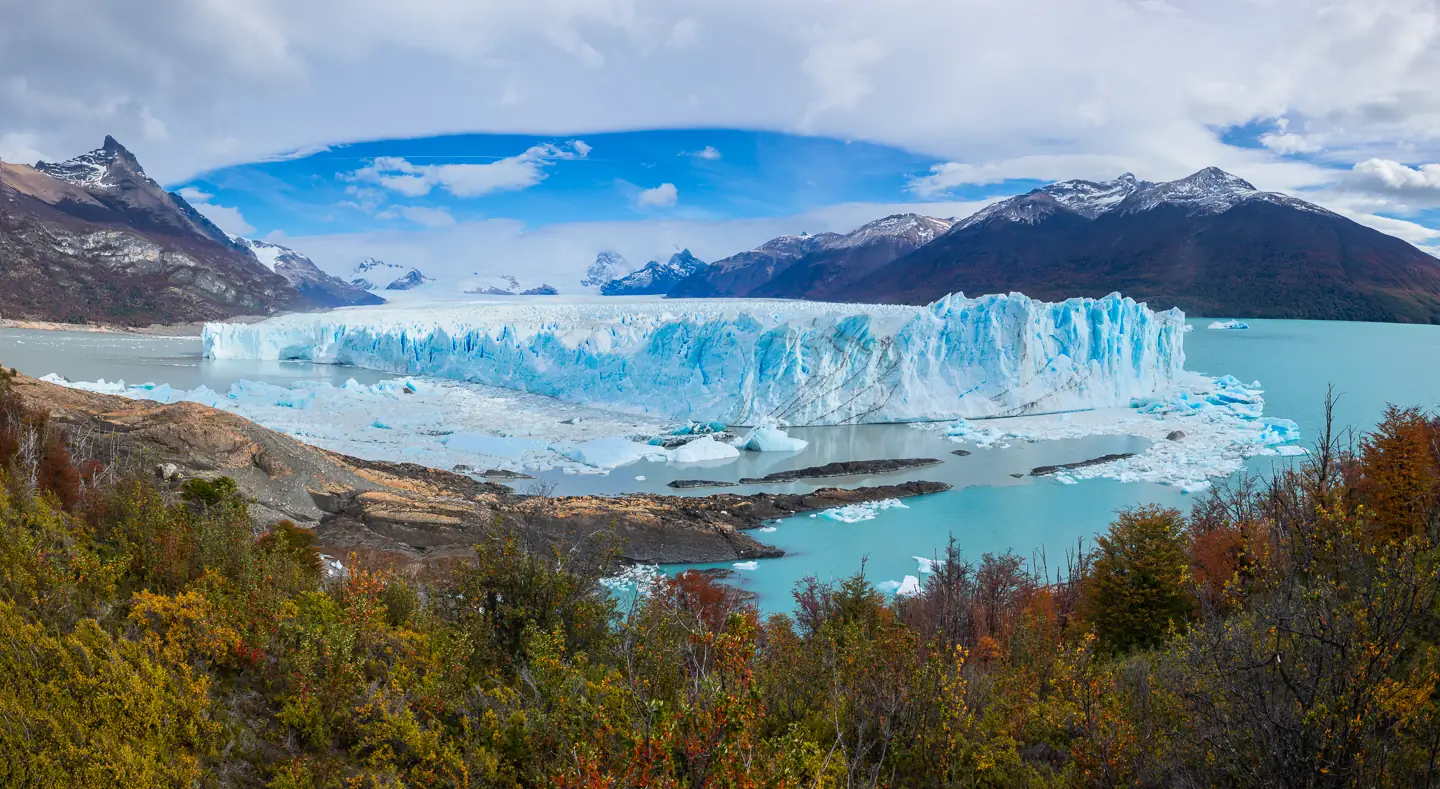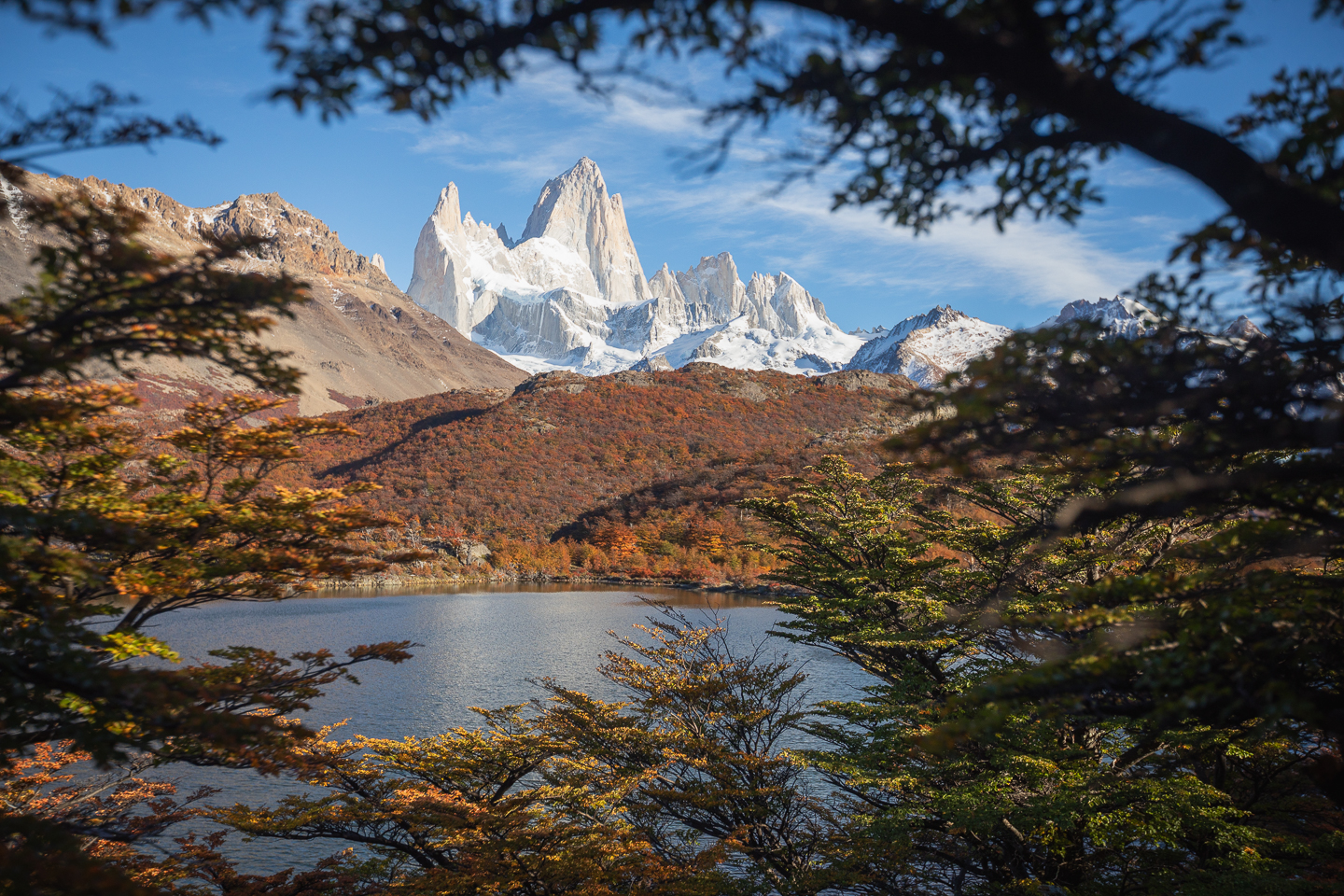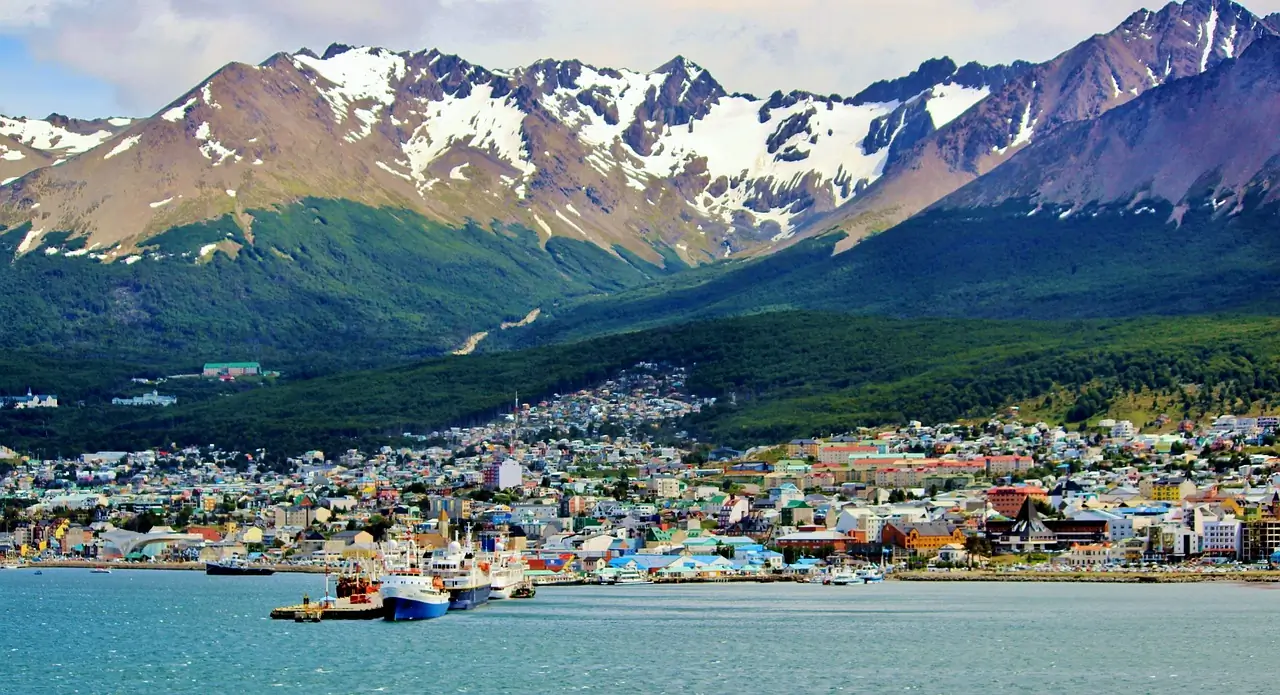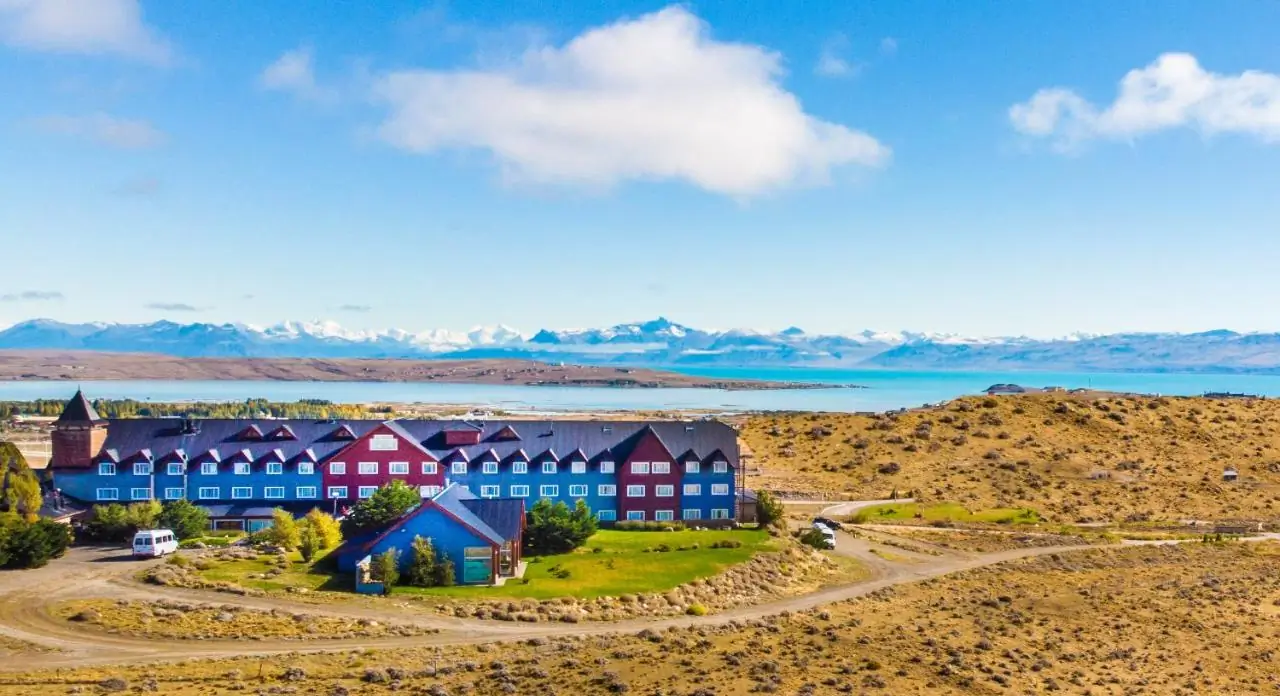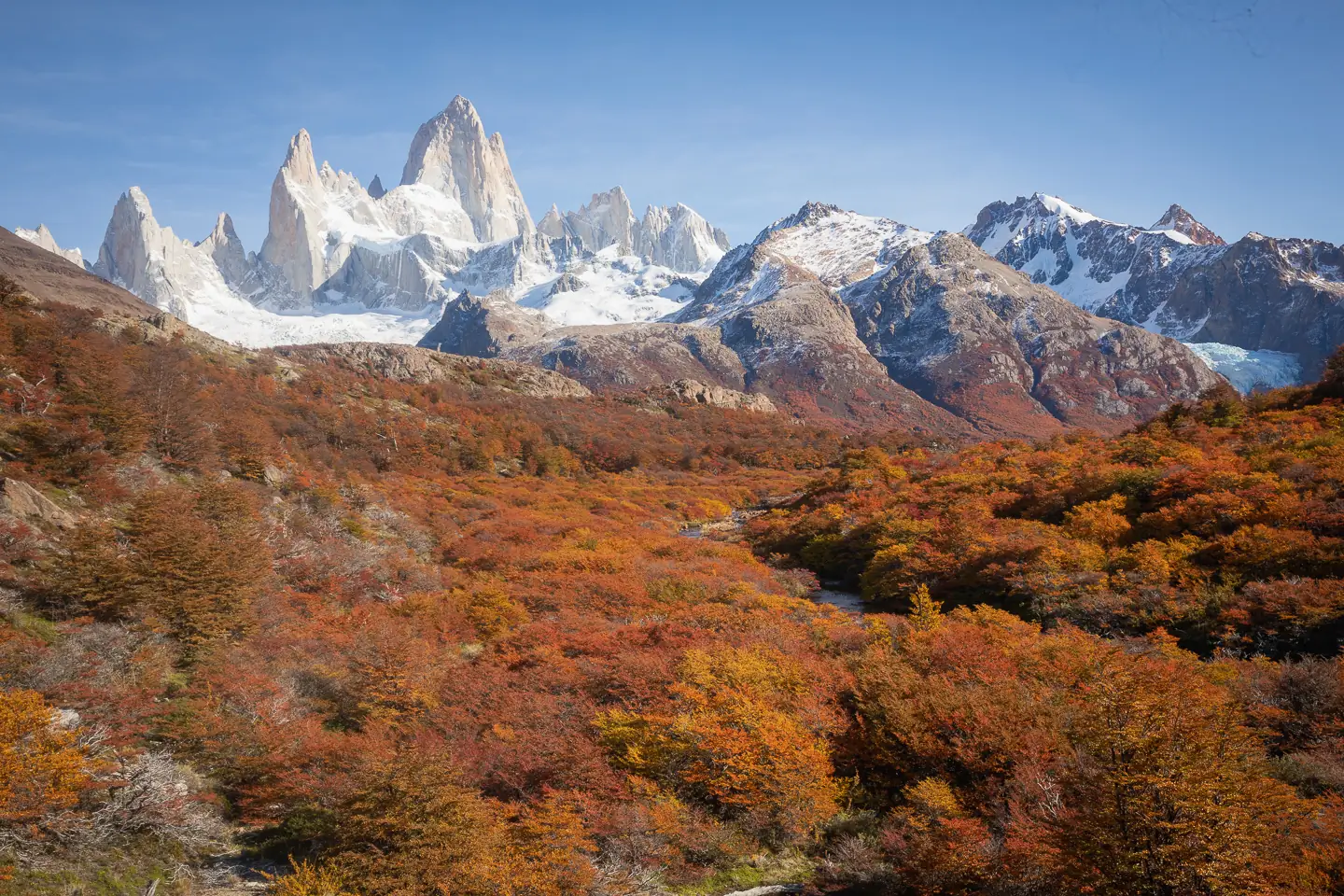Patagonie méridionale
Southern Patagonia, Argentina, is a breathtaking region of rugged landscapes, towering glaciers, and pristine wilderness, offering unparalleled adventures in nature and awe-inspiring views of the Andes.
Southern Patagonia, Argentina’s untamed frontier, beckons with its raw, windswept beauty. Towering granite spires of Fitz Roy, the vast blue expanse of Perito Moreno Glacier, and endless steppe dotted with guanacos define this land of extremes. A paradise for trekkers and adventurers, it offers solitude, stark landscapes, and the thrill of standing at the edge of the world.
L'essentiel
- Meilleurs mois pour visiter : Décembre, février, janvier, novembre
Visites et excursions d'une journée
Perito Moreno Glacier Tour
One of the most iconic attractions in Southern Patagonia, the Perito Moreno Glacier is a must-see. Located in Los Glaciares National Park, this massive glacier is one of the few in the world that is still advancing. Visitors can take a guided tour that includes a boat ride to get up close to the glacier, or opt for a trekking experience on the ice itself. The glacier’s sheer size and the thunderous sound of ice calving into the water make this an unforgettable experience.
Mount Fitz Roy and El Chaltén
For those who love hiking and breathtaking landscapes, a trip to Mount Fitz Roy and the nearby village of El Chaltén is essential. Known as the “Trekking Capital of Argentina,” El Chaltén offers numerous trails that cater to all levels of hikers. The most popular hike leads to the base of Mount Fitz Roy, offering stunning views of the jagged peaks and turquoise lagoons. The village itself is charming, with cozy lodges and local eateries serving Patagonian specialties.
Parc national Torres del Paine
Although technically in Chile, Torres del Paine National Park is easily accessible from Southern Patagonia and is a favorite for day trips. The park is renowned for its dramatic mountain ranges, bright blue icebergs, and golden pampas. Popular activities include hiking the famous “W” circuit, wildlife spotting, and boat tours on Grey Lake. The park’s diverse landscapes and abundant wildlife make it a paradise for nature lovers.
Ushuaia and Tierra del Fuego
Known as the “End of the World,” Ushuaia is the southernmost city in Argentina and serves as a gateway to Tierra del Fuego National Park. Visitors can explore the park’s rugged terrain, dense forests, and serene lakes. A popular day trip includes a boat tour along the Beagle Channel, where you can spot sea lions, penguins, and a variety of seabirds. Ushuaia also offers museums and historical sites that delve into the region’s maritime history.
Estancias and Gaucho Culture
Experience the traditional way of life in Southern Patagonia by visiting one of the many estancias (ranches) in the region. These working farms offer a glimpse into the daily life of gauchos (Argentine cowboys) and often include activities such as horseback riding, sheep shearing demonstrations, and traditional asado (barbecue) meals. It’s a unique opportunity to immerse yourself in the local culture and enjoy the vast, open landscapes of Patagonia.
Punta Tombo Penguin Colony
For wildlife enthusiasts, a visit to the Punta Tombo Penguin Colony is a must. Located on the Atlantic coast, this colony is home to over half a million Magellanic penguins. Visitors can walk along designated paths to observe the penguins in their natural habitat, especially during the breeding season from September to April. The site also offers interpretive centers that provide information about the penguins and the local ecosystem.
Lake Argentino and Boat Tours
Lake Argentino, the largest freshwater lake in Argentina, is a hub for various boat tours that explore its stunning surroundings. These tours often include stops at smaller glaciers, such as Upsala and Spegazzini, and provide opportunities for wildlife spotting. The lake’s crystal-clear waters and surrounding snow-capped peaks create a picturesque setting that is perfect for photography and relaxation.
Quand visiter
Seasonal Breakdown: Southern Patagonia
Southern Patagonia experiences a harsh, unpredictable climate with strong winds and dramatic seasonal shifts. The region is best divided into four distinct seasons, each offering unique advantages and challenges for travelers.
Summer (December – February)
Météo : The warmest months, with temperatures ranging from 10°C to 20°C (50°F to 68°F). Days are long (up to 17 hours of daylight), but winds can be intense, and rain is common. Nights remain chilly.
- Pour : Ideal for hiking, wildlife spotting (penguins, whales), and accessing remote areas like Torres del Paine or Perito Moreno Glacier. All tourist services operate.
- Cons : Peak tourist season means higher prices and crowded trails. Book accommodations and tours months in advance.
- Événements : Fiesta Nacional del Lago (January) in Río Gallegos features folk music and local culture.
Autumn (March – May)
Météo : Temperatures drop to 5°C–15°C (41°F–59°F). Winds lessen, and autumn foliage paints the landscapes in vibrant hues. Rainfall decreases.
- Pour : Fewer crowds, lower prices, and stunning photography conditions. Still suitable for hiking.
- Cons : Some lodges and tours begin closing in late April. Weather becomes more unpredictable.
- Événements : Harvest festivals in small towns like El Calafate celebrate local traditions.
Winter (June – August)
Météo : Bitterly cold, with temperatures between -5°C and 5°C (23°F–41°F). Snow blankets the Andes, and daylight shrinks to 8 hours. Roads may close due to storms.
- Pour : Snowshoeing, skiing (Cerro Castor), and surreal icy landscapes. Minimal tourists and deep discounts.
- Cons : Many trails and attractions (e.g., boat tours to glaciers) are inaccessible. Limited services.
- Événements : Winter solstice celebrations in Ushuaia, the “End of the World.”
Spring (September – November)
Météo : Temperatures rise to 0°C–12°C (32°F–54°F). Winds return, but wildflowers bloom, and wildlife becomes active.
- Pour : Shoulder season offers a balance of accessibility and solitude. Penguins return to coastal areas.
- Cons : Unpredictable storms may disrupt travel plans. Some services reopen slowly.
- Événements : Sheep-shearing festivals in rural estancias showcase Patagonian ranch life.
Overall Recommendation
Best for most travelers: Visit between Novembre et début mars for optimal weather and open attractions. December–February suits adventurers willing to brave crowds, while March–April is perfect for solitude and autumn colors. Budget travelers or winter enthusiasts should consider June–August, but prepare for limited access.
Considérations
Peak season (summer) demands early bookings and higher budgets. Shoulder seasons (spring/autumn) offer better deals and flexibility. Winter travel requires self-sufficiency and checking road conditions. Regardless of season, pack layers—Patagonia’s weather changes rapidly!
Ce qu'il faut emporter
Essentials for Southern Patagonia’s Wild Climate
Southern Patagonia is infamous for its fierce winds, rapid weather shifts, and rugged terrain. Packing smart means preparing for all conditions—blistering sun, icy gusts, and sudden rain—while staying mobile for hiking and exploration.
- Windproof & Waterproof Jacket: A high-quality shell is non-negotiable to combat Patagonia’s relentless winds and unpredictable storms.
- Thermal Base Layers: Merino wool or synthetic fabrics for layering, as temperatures swing drastically between day and night.
- Bottes de randonnée robustes : Ankle support and waterproofing are key for rocky trails and muddy paths.
- Buff or Balaclava: Protects your face from windburn and dust during treks.
- High-SPF Sunscreen & Lip Balm: The ozone layer is thin here, and UV rays are intense even on cloudy days.
- Microspikes or Trekking Poles: Essential for icy trails (especially in Torres del Paine or Perito Moreno Glacier).
- Power Bank: Cold drains batteries fast; keep devices charged for navigation and emergencies.
Gear for Adventure & Comfort
Whether trekking, glacier hiking, or navigating gravel roads, these items will elevate your experience.
- Lightweight Dry Bag: Keeps gear dry during river crossings or sudden downpours.
- Jumelles : For spotting condors, guanacos, and distant glaciers.
- Reusable Water Bottle with Insulation: Prevents freezing and reduces plastic waste in remote areas.
- Cash (Argentine Pesos): Many remote refugios and small towns don’t accept cards.
Se déplacer
Public Transportation in Southern Patagonia
Public transportation in Southern Patagonia is limited but functional, especially in larger towns like El Calafate and Ushuaia. Buses are the most common mode of public transport, connecting major cities and tourist destinations. Companies like Taqsa et Marga operate long-distance routes, offering comfortable and reliable services. In smaller towns, local buses or colectivos are available, though schedules can be infrequent.
Options de transport privé
Renting a car is a popular choice for exploring Southern Patagonia, as it provides flexibility to visit remote areas like Los Glaciares National Park or Tierra del Fuego. Major car rental companies operate in El Calafate and Ushuaia. Be prepared for long distances and varying road conditions, including gravel roads. Always check weather forecasts and carry extra fuel, as gas stations can be sparse in remote regions.
Vols intérieurs
For covering long distances quickly, domestic flights are a convenient option. Aerolíneas Argentinas and low-cost carriers like Flybondi operate flights between major cities such as Buenos Aires, El Calafate, and Ushuaia. Ushuaia’s Malvinas Argentinas International Airport is a key hub for travelers heading to Antarctica or exploring Tierra del Fuego.
Cycling and Hiking
For the adventurous, cycling and hiking are excellent ways to experience Southern Patagonia’s stunning landscapes. Many trails, such as those in Torres del Paine (just across the border in Chile) or Tierra del Fuego National Park, are well-marked and accessible. Cyclists should be prepared for strong winds and unpredictable weather, while hikers should carry proper gear and maps.
Boat Travel
Boat travel is essential for exploring Southern Patagonia’s waterways and fjords. Ferries operate between Punta Arenas (Chile) and Porvenir, providing access to Tierra del Fuego. Additionally, boat tours are available for visiting Perito Moreno Glacier or navigating the Beagle Channel, offering unique perspectives of the region’s natural beauty.
Tips for Getting Around
- Plan ahead, especially for long-distance travel, as services can be limited.
- Carry cash, as credit cards may not be accepted in remote areas.
- Dress in layers and prepare for sudden weather changes.
- Check road conditions and ferry schedules in advance, particularly during winter months.
Culture
Geography and Environment
Southern Patagonia, located in the southernmost region of Argentina, is characterized by its vast, rugged landscapes. The area is dominated by the Andes Mountains to the west, which give way to expansive steppes and arid plains to the east. The region is also home to the iconic Perito Moreno Glacier, one of the few glaciers in the world that is still advancing. The harsh climate, with strong winds and cold temperatures, has shaped both the environment and the way of life for its inhabitants.
Patrimoine indigène
The indigenous Tehuelche people were the original inhabitants of Southern Patagonia, living as nomadic hunters and gatherers for thousands of years before the arrival of European settlers. Their culture was deeply connected to the land, with a rich tradition of storytelling, art, and spiritual practices. Although their population declined significantly due to colonization and disease, their legacy remains an important part of the region’s cultural identity.
European Settlement and Gaucho Culture
In the late 19th century, European settlers, primarily from Spain, Italy, and Wales, began to establish farms and ranches in Southern Patagonia. This led to the development of the gaucho culture, which is still prevalent today. Gauchos, or Argentine cowboys, are known for their horsemanship, traditional clothing, and strong sense of independence. The gaucho lifestyle is deeply intertwined with the region’s rural economy, particularly sheep farming, which remains a key industry.
Modern Influences and Tourism
In recent decades, Southern Patagonia has become a major tourist destination, attracting visitors from around the world who come to experience its natural beauty and outdoor activities. The region’s national parks, such as Los Glaciares National Park, offer opportunities for hiking, mountaineering, and wildlife observation. Tourism has also brought new cultural influences, with a growing number of international visitors and expatriates contributing to the region’s evolving cultural landscape.
cuisine
The cuisine of Southern Patagonia reflects its harsh environment and rural lifestyle. Lamb is a staple, often prepared as asado (barbecue), a traditional Argentine cooking method. Other common dishes include empanadas, filled pastries, and locro, a hearty stew made with corn, beans, and meat. The region is also known for its production of artisanal cheeses and chocolates, particularly in the Welsh-influenced town of Trelew.
Fêtes et traditions
Southern Patagonia hosts a variety of festivals and cultural events throughout the year, many of which celebrate the region’s unique heritage. The Fiesta Nacional del Lúpulo (National Hop Festival) in El Bolsón and the Fiesta Nacional del Cordero (National Lamb Festival) in Río Gallegos are popular events that showcase local traditions, music, and cuisine. These festivals provide an opportunity for both locals and visitors to experience the vibrant culture of the region.
